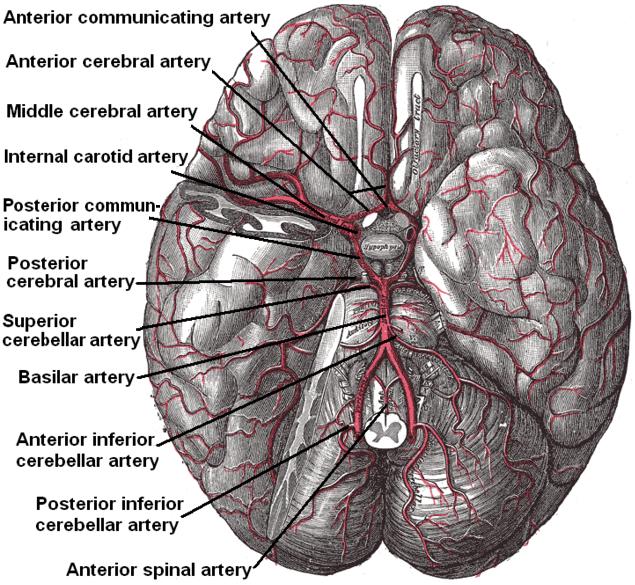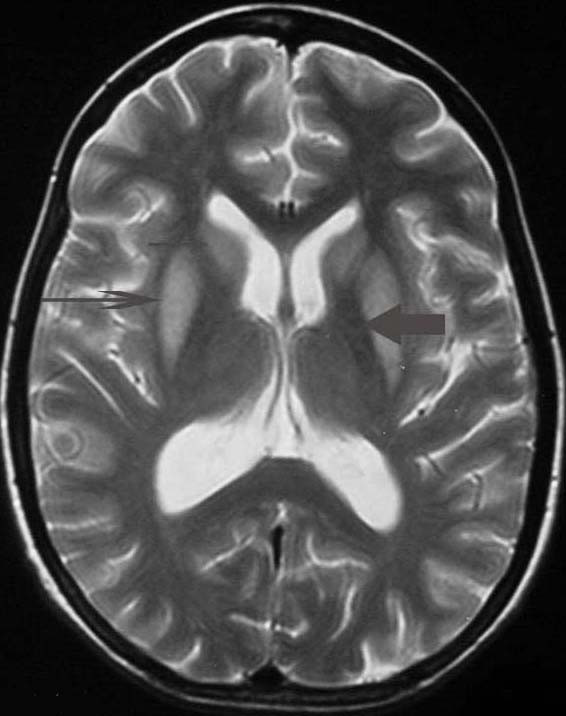|
Basilar Part Of The Pons
The basilar part of pons, also known as basis pontis, is the ventral part of the pons; the dorsal part is known as the pontine tegmentum. The basilar pons makes up two thirds of the pons within the brainstem. It has a ridged appearance with a shallow groove at the midline. This groove is called the basilar sulcus and is covered by the basilar artery, which feeds into the Circle of Willis and provides blood supply to the brainstem and cerebellum. The basilar pons has this kind of appearance due to the fibers that come out of the pons and enter the cerebellum. This part of the brainstem contains fibers from the corticospinal tract (a descending pathway for neurons to reach other structures in the body), pontine nuclei, and transverse pontine fibers. The corticospinal tract carries neurons from the primary motor cortex in the brain to the spinal cord, aiding in voluntary motor movement of the body. In addition to passing through the basilar pons, corticospinal tract fibers go through o ... [...More Info...] [...Related Items...] OR: [Wikipedia] [Google] [Baidu] |
Pons
The pons (from Latin , "bridge") is part of the brainstem that in humans and other bipeds lies inferior to the midbrain, superior to the medulla oblongata and anterior to the cerebellum. The pons is also called the pons Varolii ("bridge of Varolius"), after the Italian anatomist and surgeon Costanzo Varolio (1543–75). This region of the brainstem includes neural pathways and tracts that conduct signals from the brain down to the cerebellum and medulla, and tracts that carry the sensory signals up into the thalamus.Saladin Kenneth S.(2007) Anatomy & physiology the unity of form and function. Dubuque, IA: McGraw-Hill Structure The pons is in the brainstem situated between the midbrain and the medulla oblongata, and in front of the cerebellum. A separating groove between the pons and the medulla is the inferior pontine sulcus. The superior pontine sulcus separates the pons from the midbrain. The pons can be broadly divided into two parts: the basilar part of the pons (ventral ... [...More Info...] [...Related Items...] OR: [Wikipedia] [Google] [Baidu] |
Pontine Tegmentum
Pontine may refer to: * Having to do with the pons, a structure located in the brain stem (from ''pons'', "bridge") * Pontine Marshes, a region of Italy near Rome * Pontine Islands The Pontine Islands (, also ; it, Isole Ponziane ) are an archipelago in the Tyrrhenian Sea off the coast of Lazio region, Italy. The islands were collectively named after the largest island in the group, Ponza. The other islands in the archipe ..., islands of Italy near Circeo See also {{disambig ... [...More Info...] [...Related Items...] OR: [Wikipedia] [Google] [Baidu] |
Pontine Nuclei
Pontine may refer to: * Having to do with the pons, a structure located in the brain stem (from ''pons'', "bridge") * Pontine Marshes, a region of Italy near Rome * Pontine Islands The Pontine Islands (, also ; it, Isole Ponziane ) are an archipelago in the Tyrrhenian Sea off the coast of Lazio region, Italy. The islands were collectively named after the largest island in the group, Ponza. The other islands in the archipe ..., islands of Italy near Circeo See also {{disambig ... [...More Info...] [...Related Items...] OR: [Wikipedia] [Google] [Baidu] |
Lacunar Stroke
Lacunar stroke or lacunar cerebral infarct (LACI) is the most common type of ischemic stroke, resulting from the occlusion of small penetrating arteries that provide blood to the brain's deep structures. Patients who present with symptoms of a lacunar stroke, but who have not yet had diagnostic imaging performed, may be described as having lacunar stroke syndrome (LACS). Much of the current knowledge of lacunar strokes comes from C. Miller Fisher's cadaver dissections of post-mortem stroke patients. He observed "lacunae" (empty spaces) in the deep brain structures after occlusion of 200–800 μm penetrating arteries and connected them with five classic syndromes. These syndromes are still noted today, though lacunar infarcts are diagnosed based on clinical judgment and radiologic imaging. Signs and symptoms Each of the five classical lacunar syndromes has a relatively distinct symptom complex. Symptoms may occur suddenly, progressively, or in a fluctuating (e.g., the cap ... [...More Info...] [...Related Items...] OR: [Wikipedia] [Google] [Baidu] |
Lacunar Stroke
Lacunar stroke or lacunar cerebral infarct (LACI) is the most common type of ischemic stroke, resulting from the occlusion of small penetrating arteries that provide blood to the brain's deep structures. Patients who present with symptoms of a lacunar stroke, but who have not yet had diagnostic imaging performed, may be described as having lacunar stroke syndrome (LACS). Much of the current knowledge of lacunar strokes comes from C. Miller Fisher's cadaver dissections of post-mortem stroke patients. He observed "lacunae" (empty spaces) in the deep brain structures after occlusion of 200–800 μm penetrating arteries and connected them with five classic syndromes. These syndromes are still noted today, though lacunar infarcts are diagnosed based on clinical judgment and radiologic imaging. Signs and symptoms Each of the five classical lacunar syndromes has a relatively distinct symptom complex. Symptoms may occur suddenly, progressively, or in a fluctuating (e.g., the cap ... [...More Info...] [...Related Items...] OR: [Wikipedia] [Google] [Baidu] |
Central Pontine Myelinolysis
Central pontine myelinolysis is a neurological condition involving severe damage to the myelin sheath of nerve cells in the ''pons'' (an area of the brainstem). It is predominately iatrogenic (treatment-induced), and is characterized by acute paralysis, dysphagia (difficulty swallowing), dysarthria (difficulty speaking), and other neurological symptoms. Central pontine myelinolysis was first described as a disorder in 1959. The original paper described four cases with fatal outcomes, and the findings on autopsy. The disease was described as a disease of alcoholics and malnutrition. 'Central pontine' indicated the site of the lesion and 'myelinolysis' was used to emphasise that myelin was affected. The authors intentionally avoided the term 'demyelination' to describe the condition, in order to differentiate this condition from multiple sclerosis and other neuroinflammatory disorders. Since this original description, demyelination in other areas of the central nervous system asso ... [...More Info...] [...Related Items...] OR: [Wikipedia] [Google] [Baidu] |
Hyponatremia
Hyponatremia or hyponatraemia is a low concentration of sodium in the blood. It is generally defined as a sodium concentration of less than 135 mmol/L (135 mEq/L), with severe hyponatremia being below 120 mEq/L. Symptoms can be absent, mild or severe. Mild symptoms include a decreased ability to think, headaches, nausea, and poor balance. Severe symptoms include confusion, seizures, and coma; death can ensue. The causes of hyponatremia are typically classified by a person's body fluid status into low volume, normal volume, or high volume. Low volume hyponatremia can occur from diarrhea, vomiting, diuretics, and sweating. Normal volume hyponatremia is divided into cases with dilute urine and concentrated urine. Cases in which the urine is dilute include adrenal insufficiency, hypothyroidism, and drinking too much water or too much beer. Cases in which the urine is concentrated include syndrome of inappropriate antidiuretic hormone secretion (SIADH). High vo ... [...More Info...] [...Related Items...] OR: [Wikipedia] [Google] [Baidu] |


